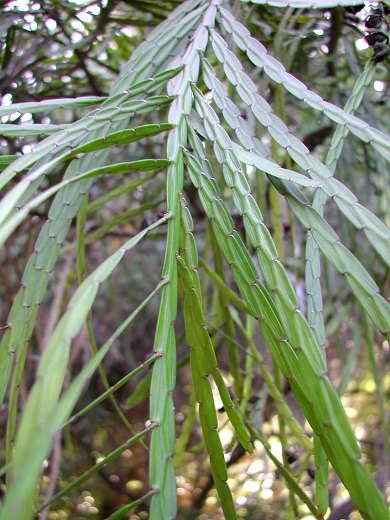Ribbon Tree
Germinating the seeds Pre-treatment -- Scrape each seed by rolling it over coarse sandpaper or a nail file several times to scratch the hard seed coat, so water can enter easier. Next fill a small cup with 1-2 ounces (30-60 mL) of very warm tap water (not scalding hot) and place the seeds in it. Keep the cup in a warm room. Within a day or two, the seeds may swell up a bit, and when they do, remove them and plant them as described in the next paragraph. If any seeds don't sprout within 48 hours, repeat the scraping and soaking, but use hotter water. The seeds should plump up from the second 48 hour soaking in water, but plant any seeds that do not. Planting -- Start with small pots or cups that are at
least 2 inches tall (5 cm), with drainage holes. Use well-draining soil. I use a mix of 1 part
coco fiber Fill each pot, put a seed on top, and cover with 1/4 inch (6 mm) of soil. Add water until the soil is evenly moist, but not fully saturated. I get good germination at 65-77 degrees F (18-25°C). I've never tried sprouting them outside this temperature range.
I recommend placing a
minimum/maximum thermometer They should start sprouting within about 2 to 4 weeks, but allow up to 8 weeks for any slow ones. Once they sprout, give bright, indirect light. A bright LED or fluorescent bulb kept 4 inches (10 cm) away provides the right amount of light (See: "Growing indoors with LED lights") Fertilizing -- For the first 8 weeks, feed weekly with a small amount of diluted liquid fertilizer (1/8 strength). Hydroponic fertilizer is ideal for young seedlings, since it is easily absorbed and complete. After 8 weeks, you may switch to a granular fertilizer that contains micronutrients, or continue feeding weekly with some diluted liquid fertilizer. Temperature & humidity -- Carmichaelia grows well between 45 and 80 degrees F (7-27°C), with cool nights. I have no information on well it will do outside that temperature range. Feel free to experiment with rooted cuttings. Lighting -- It prefers mostly sunny conditions. In warmer climates, some protection from strong afternoon sun may be needed. Also keep the pot shaded in warmer climates, perhaps by placing the pot inside a larger clay pot. Watering -- Carmichaelia likes soil that is lightly moist throughout. Avoid letting it dry out completely, but also avoid keeping it constantly saturated. Transplanting -- When your plants are 4 inches (10 cm) tall, transplant to larger pots. Water the soil first, to keep the soil ball from breaking apart, which can damage the roots. Once the plants get about 12 inches tall (30 cm), transplant them to a 2-5 gallon pots (8-18 liters). After 2-3 years, they might need 10 gallons (40 liters) or more.. although smaller pots might work if the trees are pruned back regularly. You may prune the plants to any size that is convenient. Pests to watch for -- mealy bugs, scale (small brown disks - hard to see), spider mites, slugs & snails. Try using insecticidal soap spray before using stronger remedies, since some may harm the plant. Enjoy your plants! - Jeff Strange Wonderful Things
|
|||||||||


